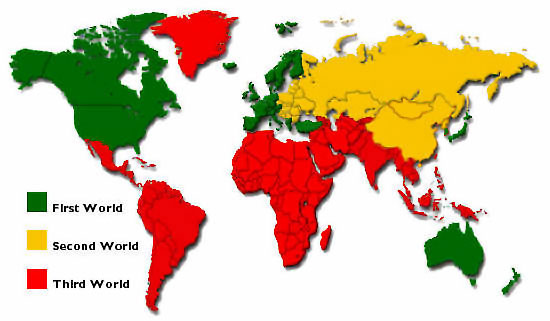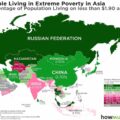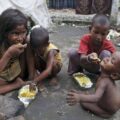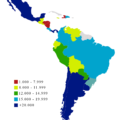The phrase ‘Third World Countries’ originated in 1952 during the time of the Cold War. Alfred Sauvy, a French economic historian, coined the phrase, the term Third World referred to the developing countries of Asia, Africa, and Latin America, the nations not aligned with either the First World or the Second World. This usage has become relatively rare due to the ending of the Cold War. In the decade following the fall of the Soviet Union and the end of the Cold War in 1991, the term Third World was used interchangeably with developing countries, but the concept has become outdated as it no longer represents the current political or economic state of the world. Strictly speaking, “Third World” was a political, rather than an economic, grouping. Since about the 2000s the term Third World has been used less and less. It is being replaced with terms such as developing countries, least developed countries or the Global South. SEE: Poorest Country in the World
Problems and Issues Affecting Third World Countries
Third World countries are besieged with numerous issues that are acting as barriers in their development. Today, the term is referred to nations, which are poor and underdeveloped. Almost all of the Third World countries are grappling with the problems of poverty, scarcity of water and electricity, poor infrastructure, low educational standards, and healthcare problems. Poverty is one of the biggest challenges that the Third World Countries are grappling with. It has been estimated that around 1.3 billion people who are living in Third World Countries live on an income of less than $1.50 per day which makes it really hard to live a decent life. Poverty has a devastating effect on the person as well as the nation. Poverty leads to hunger and malnutrition, which is a common feature of these nations.
Clean drinking water is a basic necessity, but in a majority of these countries, a significant part of the population does not have access to clean drinking water. Poor quality of roads, highways, and other infrastructure have prevented these nations from joining the ranks of developed countries.
Education is another fundamental right that is not available to many people in these countries. Due to poverty or other reasons, many people force their children into jobs instead of enrolling them in schools. The lack of education hampers the overall development of the children. Often these children are employed in hazardous jobs which puts their health and lives at risk. There are many other problems affecting Third World Countries such as corruption, poor governance, lack of electricity, too much dependence on foreign debt, etc.
Education in Third World Countries
The Third World countries are plagued by various problems, but the one that is most affecting these nations and is hindering their social and economic progress is poor educational infrastructure and high school dropout rate. According to a report by UNESCO, twenty percent of people in these Third World nations are unable to make it past primary school. To make matters worse, these people also lack skills for work, which makes it extremely tough for them to get employment. The UNESCO report paints a dismal picture of the state of education in these nations. There are some 250 million children in Third World nations who are of primary school age and still are unable to read or write. Approximately 71 million teenagers have dropped out of secondary school. As they do not have the required skills for future employment, these teenagers are unable to get jobs. There are manifold reasons for the dismal education system in these nations and may range from poverty to being born a female.
Poverty is one of the biggest challenges that come in the way of children. Poor families are unable to afford the fees and hence find it tough to send their children to school. Even those who do get a chance to go to school drop out midway as poverty forces these children to work and help their families.
In some countries, girl students opt out of education due to the lack of separate toilets for females. Poor nations, especially those torn by conflicts and wars, are unable to spend a part of their GDP on education. Some other factors that act as the hindrance in students attaining education in Third World nations are lack of trained teachers, classrooms, and learning materials, countries plagued by violence and civil wars, long distance between the school and the student’s home, poverty, or simply belonging to the female gender. The list of 3rd world countries include :
.
| Flag | Country | Human Development Index | Population 2019 |
| Niger | 0.354 | 23,310,715 | |
| Central African Republic | 0.367 | 4,745,185 | |
| South Sudan | 0.388 | 11,062,113 | |
| Chad | 0.404 | 15,946,876 | |
| Burundi | 0.417 | 11,530,580 | |
| Sierra Leone | 0.419 | 7,813,215 | |
| Burkina Faso | 0.423 | 20,321,378 | |
| Mali | 0.427 | 19,658,031 | |
| Liberia | 0.435 | 4,937,374 | |
| Mozambique | 0.437 | 30,366,036 | |
| Eritrea | 0.44 | 3,497,117 | |
| Yemen | 0.452 | 29,161,922 | |
| Guinea Bissau | 0.455 | 1,920,922 | |
| Guinea | 0.459 | 12,771,246 | |
| Gambia | 0.46 | 2,347,706 | |
| Ethiopia | 0.463 | 112,078,730 | |
| Djibouti | 0.476 | 973,560 | |
| Malawi | 0.477 | 18,628,747 | |
| Haiti | 0.498 | 11,263,077 | |
| Afghanistan | 0.498 | 38,041,754 | |
| Sudan | 0.502 | 42,813,238 | |
| Comoros | 0.503 | 850,886 | |
| Togo | 0.503 | 8,082,366 | |
| Senegal | 0.505 | 16,296,364 | |
| Benin | 0.515 | 11,801,151 | |
| Uganda | 0.516 | 44,269,594 | |
| Madagascar | 0.519 | 26,969,307 | |
| Lesotho | 0.52 | 2,125,268 | |
| Mauritania | 0.52 | 4,525,696 | |
| Rwanda | 0.524 | 12,626,950 | |
| Solomon Islands | 0.546 | 669,823 | |
| Nepal | 0.574 | 28,608,710 | |
| Myanmar | 0.578 | 54,045,420 | |
| Angola | 0.581 | 31,825,295 | |
| Cambodia | 0.582 | 16,486,542 | |
| Zambia | 0.588 | 17,861,030 | |
| Sao Tome And Principe | 0.589 | 215,056 | |
| Vanuatu | 0.603 | 299,882 | |
| Bangladesh | 0.608 | 163,046,161 | |
| Kiribati | 0.612 | 117,606 | |
| Bhutan | 0.612 | 763,092 |





